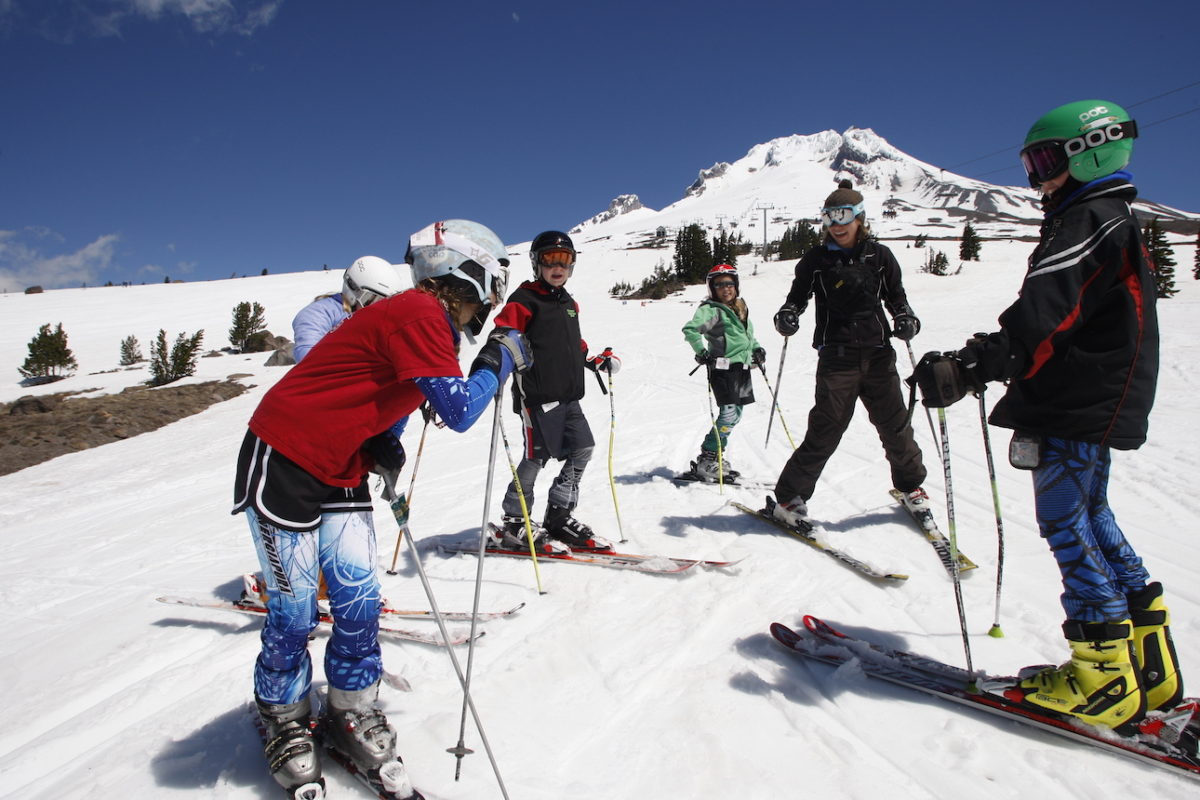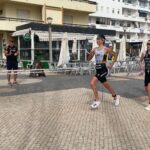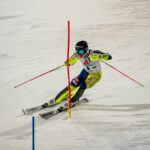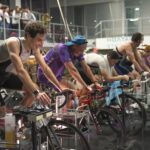Greetings from Stubai Glacier in Austria! I’m here with an outstanding group of PG athletes from back East. My work with them includes both off-snow and on-snow mental training. Though the indoor work is valuable for laying the foundation for mental training, the on-snow work is the most directly powerful (and the most fun!) because the young racers have the opportunity to strengthen their mental muscles and add tools to their mental toolboxes while actually free skiing and running gates. This on-snow mental training is so valuable because the racers can get immediate feedback from their skiing about what works and what doesn’t mentally.
My work in Stubai got me thinking about how important summer on-snow training is for enabling serious ski racers achieve their goals for the upcoming winter. As such, it is essential that racers do everything they can to get the most out of their on-snow efforts during the prep period. A lot of my on-snow work is devoted to helping racers experience “quality training,” which I define as putting their optimal effort, energy, and focus into their training with the goal of gaining its maximum benefit. So, I thought I would share some of my tips and lessons learned from my time on the glacier.
Have a Goal and Purpose
You must have a clear goal about what area you want to improve as you head out to training. For example, a good goal might be to shift your weight forward so you’re not caught “in the back seat.” You must also have a clear purpose for training each day. A purpose identifies specifically how you’re going to achieve your goal for the day. Returning to the example I just cited, your purpose might be to drive your hands forward between turns or bring your hips up to get your weight forward.
 When I’m working on the hill with racers, I will often ask them what their goal and purpose is. If they don’t know, I don’t let them train. I know that sounds harsh, but think of it this way. If you don’t have a clear goal and purpose, you won’t be working on anything to improve. You will not only not be getting better, but you will be making it harder to improve. Let me explain. When you’re not working on something to get better, you are practicing and further ingraining old habits. The more deeply ingrained those old technical, tactical, and mental habits get, the harder it is to change them. So, by not having you train if you don’t have a clear goal or purpose, you may not be improving, but, at least, you’re also not making it harder to improve.
When I’m working on the hill with racers, I will often ask them what their goal and purpose is. If they don’t know, I don’t let them train. I know that sounds harsh, but think of it this way. If you don’t have a clear goal and purpose, you won’t be working on anything to improve. You will not only not be getting better, but you will be making it harder to improve. Let me explain. When you’re not working on something to get better, you are practicing and further ingraining old habits. The more deeply ingrained those old technical, tactical, and mental habits get, the harder it is to change them. So, by not having you train if you don’t have a clear goal or purpose, you may not be improving, but, at least, you’re also not making it harder to improve.
Train like You Race
When I ask coaches and racers whether they should train like they race or race like they train, the vast majority say race like you train. Their answer seems reasonable because if you could race in the same relaxed state as when you train, the chances are you’d ski fast.
The problem is that racing like you train is impossible. Why? Because there is a big difference between training and races: races matter! So, I say train like you race. Think about everything you need to think, feel, and do in a race and then replicate that in training. By doing so, you will practice and ingrain the skills and habits that you need to ski your best in races.
When I say train like you race, I don’t mean trying to ski as fast as you can every run of training. The reality is that there are times in training, particularly during the summer, when you will be focusing on technique or tactics rather than speed. When I say train like you race, I mean putting 100% effort, focus, and intensity into whatever you are working on.
Admittedly, you probably won’t be able to train at 100%, but if you can up your efforts from, say, 70% to 90%, when you get to race day, you’ll have little trouble kicking it up to 100% because your mind and body know that it’s time to race.
By training like you race, you won’t need to do anything new or different. And races won’t feel like a big deal because you’ve been skiing at that high level in training. All of those great skills and habits that you instilled in training will naturally come out and you’ll be able to ski your fastest.
Use Keywords to Maintain Focus
Perhaps the greatest challenge you face in improving the technical and tactical aspects of your skiing is maintaining focus in training. In fact, ski racing may be the most difficult sport in which to focus because there are so many things to focus on (e.g., course, terrain, snow conditions) and so many things trying to distract you (e.g., negative thinking, homework, other people). For example, in the starting gate of a training course, you may be totally focused on, say, keeping your hands up. But, as soon as you leave the gate, you find you have a lot more important things to focus on, such as survival!
As soon as you lose your focus, you lose your ability to work on that thing you were focusing on in the starting gate. Here’s a simple rule: If you don’t focus on it, you won’t work on it. If you don’t work on it, you won’t learn it. And if you don’t learn it, you won’t be able to use it in a race.
The best way I have found to maintain focus on a training course is to develop and repeat a keyword that will remind you to focus on and practice what you are working on to improve. Returning to my example of keeping your hands up, think up a simple keyword (best to have it one or two syllables and active), such as up, drive, press, or forward. Then, in the starting gate and during the entire training run, repeat the keyword to yourself (out loud if necessary). If you’re saying the keyword, you have a much better chance of not being distracted, keeping the focus on the technique you’re working on, actually practicing it the entire training run, and ingraining it so that it is automatic.
Make Mistakes
One of the most frustrating aspects of developing as a ski racer are the mistakes that you make as you work to improve. Unlike in other sports, the consequences of mistakes in ski racing are dramatic and sometimes painful, in the forms of blowing out in training courses or crashing in races. Yet, racers often don’t realize that mistakes are an essential part of becoming a better racer. In fact, many racers view mistakes as failure; if they didn’t have a perfect run, they’ve failed. In fact, many racers I see bail out of courses at the first hint of trouble. But mistakes only mean failure when you give in to them, don’t learn from them, and keep repeating them.
Mistakes are a natural part of the learning process and offer you valuable information about what you need to work on. Mistakes are actually positive signs in ski racing because they mean you’re taking risks, moving out of your comfort zone, and working to improve. If you are not making mistakes, you’re just not pushing yourself to be your best.
Rarely has there ever been a perfect race run, even by World Cup racers. The best ski racers in the world make mistakes, so if you’re not at that level, you shouldn’t be surprised that you make mistakes too. What makes World Cup racers different is not that they don’t make mistakes, but rather how they respond to them. Instead of getting frustrated, angry, and depressed when they make mistakes, the best racers stay positive and motivated. And, importantly, they learn from their mistakes, so they don’t make them again. To ensure that mistakes mean success, immediately after a mistake, identify what exactly you did incorrectly, decide what you need to do to correct it, and focus on the correction on the next run.
Point A to Point B
The start and finish of a training course are essential parts of training. Yet, the start and finish are also the most neglected parts of training. A course can be thought of as Point A (the starting gate) to Point B (the finish line). Since the clock starts at Point A and finishes at Point B, it is important that you learn to ski your best from Point A to Point B in training.
I often see racers have weak starts or take several gates to settle into the training course and establish their rhythm before they start skiing hard. In effect, they haven’t started racing the course even though they have left the starting gate. By doing this, they are developing the habit of easing into a course, so on race day, that is what will come out. Since the race clock starts as soon as you trip the wand, this approach will cause you to be behind at the first gate and you will be playing catch up the rest of the course.
I encourage coaches to always have a starting gate set up for training courses and ideally a wand should be used as well. If there is no starting gate, pretend there is one. Train yourself to go 100% from the start. Have a strong start and attack the first gate with abandon.
Another annoying habit I see with young racers is to ease up a gate or two before the finish. Also, coaches often don’t even set a finish gate. This too creates a bad habit of letting up before Point B. This can cause you to lose focus and intensity before the training course is over often leading to a mistake or DNF when the end of the course is in sight.
Coaches should always set a finish gate in training. Be sure that, whatever you’re working on, you maintain focus and intensity through the finish line.
Start to Finish of Training Sessions
Consistency is a hallmark of a great ski racer and consistency in racing begins with consistency in training. Your goal is to put in consistent effort, energy, and focus from your first training run to your last. Unfortunately, another pet peeve of mine is seeing racers ease into their training session by using the first two runs as warm-up runs before they get really focused and intense in their efforts. This is a bad habit to get into because you don’t have that luxury on race day. As you well know, your first two runs on race day have to be all out because those are the only two you get. So, when you get into the starting gate of a training session, you should be ready to put everything you have into it.
It’s also essential that you end your training sessions with the same focus and intensity that you started with. Unfortunately, fatigue can set in when you have a few runs remaining, causing your intensity to drop and your focus to drift. If you finish your training session in this state, you will not ski well those last runs and you will surely end on a bad note and may erase the gains made in your previous runs. When you begin to tire, you need to consciously and actively “rev your engine” before those last training runs by having a more dynamic warm-up, using intense breathing, and using “fire-up” self-talk. To refocus, you can use high-energy imagery and grab onto your keywords that remind you what you are working on.
Have Patience, Persistence, and Perseverance
Two significant barriers to achieving your ski racing goals are frustration and discouragement. Let’s face it, ski racing is filled with obstacles, plateaus, and setbacks, and it’s easy to just want to give up. I think it’s especially hard for young racers these days because all of the messages they get from our sports culture is that success should be easy and they shouldn’t have to work that hard to get it. But that’s just not the way the real world works. Gosh, pursuing excellence is just plain difficult. That’s why most people never get there, because they quit when it gets hard.
I read a research study once that said that it takes 2,000 repetitions of a skill to ingrain it fully. The problem is that you can’t just make that many repetitions to really learn something. Rather, you have to have 2,000 quality repetitions, which means you may need to do several thousand more to get to that number. Also, other research shows that those who achieve excellence have put in thousands of hours of practice.
If you’re going to achieve your ski racing goals, you need the 3 Ps of training. The first P is patience, really understanding that there are no quick or easy paths to success. You must be willing to accept that it will take a long time to reach your goals. The second P is persistence, which means keeping up maximum effort even when you are tired, bored, cold, and wishing you could somewhere else. The third P is perseverance, which involves facing and overcoming those obstacles, plateaus, and setbacks that are an inevitable part of the climb up the steep mountain to your goals.
Do you want to take the next step in training your mind to ski your fastest next winter? Take a look at my online mental training courses designed just for ski racers.
Note: This article is updated presentation of a previously published article that never gets old.







